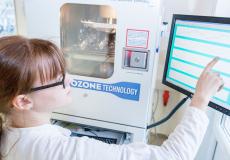Testing Elastomers for Environmental Influences
Under normal environmental ozone concentrations elastomer materials may form deep cracks which usually lead to a failure of a component. But the following conditions are prerequisite:
- a highly unsaturated polymer, e.g. NBR, NR or SBR
- a deformation > 3-5%
- an admission of ozoniferous air (an unbraked air exchange at the seal)
In practice this occurs particularly at pre-installed NBR-seals which are exposed to their environment. In contrast this does normally not occur at installed seals. To a certain degree NBR-materials can be protected against the exposure of ozone by certain additives. The effectiveness of these additives can be ascertained by ozone tests. In the process samples are exposed to a defined ozone concentration (e.g. 50 pphm) at a given stretching (e.g. 20%) over a limited period of time (e.g. 48h). Afterwards the sample is checked for cracks.
Standards: DIN 53 509, ISO 1431.

